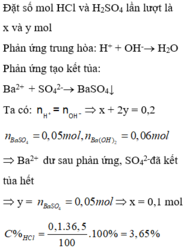Hãy nhập câu hỏi của bạn vào đây, nếu là tài khoản VIP, bạn sẽ được ưu tiên trả lời.

a)nHCl= 0,1 , nNaOh=0,4 khi phân li ra ta thu được các ion; H+, Cl- Na+, OH- Vdung dịch sau = 0,1+0,4=0,5(l)
nH+=nCl-=0,1 [H+]=[Cl-]=0,1/0,5=0,2 (M)
nNa+=nOH-=0,4 [Na+]=[OH-]=0,4/0,5=0,8
b)nH+=0,1 nOH-=0,4 --> OH- dư --> nOHdư=0,4-0,1=0,3 --> [OHdư ]=0,3/0,5=0,6 --> pOh=0,23--> ph=14-0,23=13,77

Ta có: \(n_{HCl}=0,1.0,02=0,002\left(mol\right)\Rightarrow n_{H^+}=0,002\left(mol\right)\)
\(n_{NaOH}=0,1.0,04=0,004\left(mol\right)\Rightarrow n_{OH^-}=0,004\left(mol\right)\)
\(H^++OH^-\rightarrow H_2O\)
0,002→0,002 _______ (mol)
⇒ OH- dư.
\(\Rightarrow n_{OH^-\left(dư\right)}=0,002\left(mol\right)\)
\(\Rightarrow\left[OH^-\right]=\frac{0,002}{0,2}=0,01M\)
\(\Rightarrow\left[H^+\right]=\frac{10^{-14}}{0,01}=10^{-12}\)
\(\Rightarrow pH=12\)
Bạn tham khảo nhé!

a, \(n_{HCl}=0,1.0,2=0,02\left(mol\right)=n_{H^+}=n_{Cl^-}\)
\(n_{H_2SO_4}=0,1.0,2=0,02\left(mol\right)=n_{SO_4^{2-}}\) \(\Rightarrow n_{H^+}=2n_{H_2SO_4}=0,04\left(mol\right)\)
\(n_{NaOH}=0,3.0,4=0,12\left(mol\right)=n_{Na^+}=n_{OH^-}\)
\(\Rightarrow\sum n_{H^+}=0,02+0,04=0,06\left(mol\right)\)
\(H^++OH^-\rightarrow H_2O\)
0,06__0,06 (mol)
⇒ nOH- dư = 0,12 - 0,06 = 0,06 (mol)
\(\Rightarrow\left\{{}\begin{matrix}\left[Cl^-\right]=\dfrac{0,02}{0,1+0,3}=0,05\left(M\right)\\\left[SO_4^{2-}\right]=\dfrac{0,02}{0,1+0,3}=0,05\left(M\right)\\\left[Na^+\right]=\dfrac{0,12}{0,1+0,3}=0,3\left(M\right)\\\left[OH^-\right]=\dfrac{0,06}{0,1+0,3}=0,15\left(M\right)\end{matrix}\right.\)
b, pH = 14 - (-log[OH-]) ≃ 13,176

n NaOH=0.005
cM(NaOH)=0.005/0.5=0.01
-->p(OH)=-log(0.01)=2
-->pH=14-2=12
chọn b

a, \(n_{Ba\left(OH\right)_2}=0,1.0,1=0,01\left(mol\right)=n_{Ba^{2+}}\)
\(\Rightarrow n_{OH^-}=2n_{Ba\left(OH\right)_2}=0,02\left(mol\right)\)
\(n_{NaOH}=0,1.0,1=0,01\left(mol\right)=n_{Na^+}=n_{OH^-}\)
⇒ ΣnOH- = 0,02 + 0,01 = 0,03 (mol)
\(n_{H_2SO_4}=0,4.0,0175=0,007\left(mol\right)=n_{SO_4^{2-}}\)
\(\Rightarrow n_{H^+}=2n_{H_2SO_4}=0,014\left(mol\right)\)
\(H^++OH^-\rightarrow H_2O\)
0,014___0,014 (mol) ⇒ nOH- dư = 0,03 - 0,014 = 0,016 (mol)
\(Ba^{2+}+SO_4^{2-}\rightarrow BaSO_4\)
0,007____0,007_____0,007 (mol) ⇒ nBa2+ dư = 0,01 - 0,007 = 0,003 (mol)
⇒ m = 0,007.233 = 1,631 (g)
\(\left[OH^-\right]=\dfrac{0,016}{0,1+0,4}=0,032\left(M\right)\)
\(\left[Ba^{2+}\right]=\dfrac{0,003}{0,1+0,4}=0,006\left(M\right)\)
\(\left[Na^+\right]=\dfrac{0,01}{0,1+0,4}=0,02\left(M\right)\)
b, pH = 14 - (-log[OH-]) ≃ 12,505
\(n_{Ba^{2+}}=0,1.0,1=0,01\left(mol\right)\)
\(n_{SO_4^{2-}}=0,4.0,0175=7.10 ^{-3}\left(mol\right)\)
\(Ba^{2+}+SO_4^{2-}\rightarrow BaSO_4\downarrow\)
\(\Rightarrow m=m_{BaSO_4}=7.10^{-3}.233=1,631\left(g\right)\)
Ta có:
\(n_{H^+}=0,4.0,0175.2=0,014\left(mol\right)\)
\(n_{OH^-}=0,1.0,1.2+0,1.0,1=0,03\left(mol\right)\)
Trong dung dịch X:
\(n_{OH^-}=0,03-0,014=0,016\left(mol\right)\)\(\Rightarrow\left[OH^-\right]=\dfrac{0,016}{0,1+0,4}=0,032\left(M\right)\)
\(n_{Ba^{2+}}=0,01-7.10^{-3}=3.10^{-3}\left(mol\right)\Rightarrow\left[Ba^{2+}\right]=\dfrac{3.10^{-3}}{0,1+0,4}=6.10^{-3}\left(M\right)\)
\(n_{Na^+}=0,1.0,1=0,01\left(mol\right)\Rightarrow\left[Na^+\right]=0,02\)
\(pOH=-lg\left(0,032\right)\approx1,5\Rightarrow pH=14-1,5=12,5\)

dung dịch Z có pH=13-> dung dịch Z chứa OH có nồng độ là 0,1M
ta có nH+=0,5anH+=0,5a mol ,nOHnOH = 0,5b mol
H++OH→H2OH++OH→H2O
dung dịch Z chứa OH →nOHdư=0,5b−0,5a→nOHdư=0,5b−0,5a mol
→[OH−]=0,5b−0,5aa+b=0,1M→0,4b−0,6a=0(1)→[OH−]=0,5b−0,5aa+b=0,1M→0,4b−0,6a=0(1)
theo đề bài -> a + b = 1 (2)
giải hệ chứa (1) và (2) -> a = 0,4 và b = 0,6

Đáp án B
Ta có P2O5 + 3H2O → 2H3PO4
nH3PO4= 2.nP2O5=0,03 mol, nNaOH=0,04 mol
Ta xét tỉ lệ T= nNaOH/ nH3PO4= 0,04/0,03= 1,333
→ 1 < T < 2
→ Khi H3PO4 tác dụng với NaOH xảy ra 2 phương trình sau:
H3PO4 + NaOH → NaH2PO4 + H2O
x x x mol
H3PO4 + 2NaOH → Na2HPO4 + 2 H2O
y 2y y mol
ta có: nH3PO4 = x+ y= 0,03 ; nNaOH= x+2y= 0,04
Suy ra x= 0,02 ; y= 0,01
→CM NaH2PO4= 0,02/0,4= 0,05M ;
CM Na2HPO4= 0,01/0,4= 0,025M
